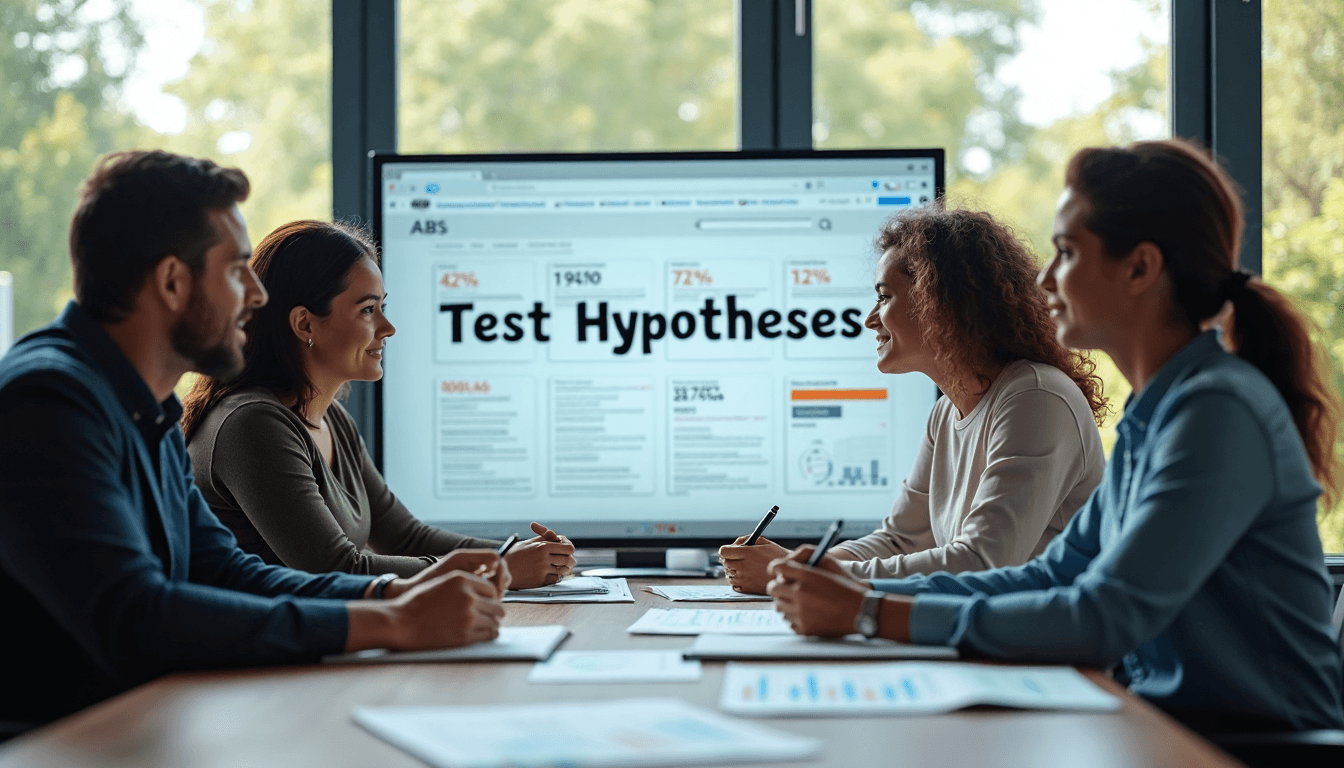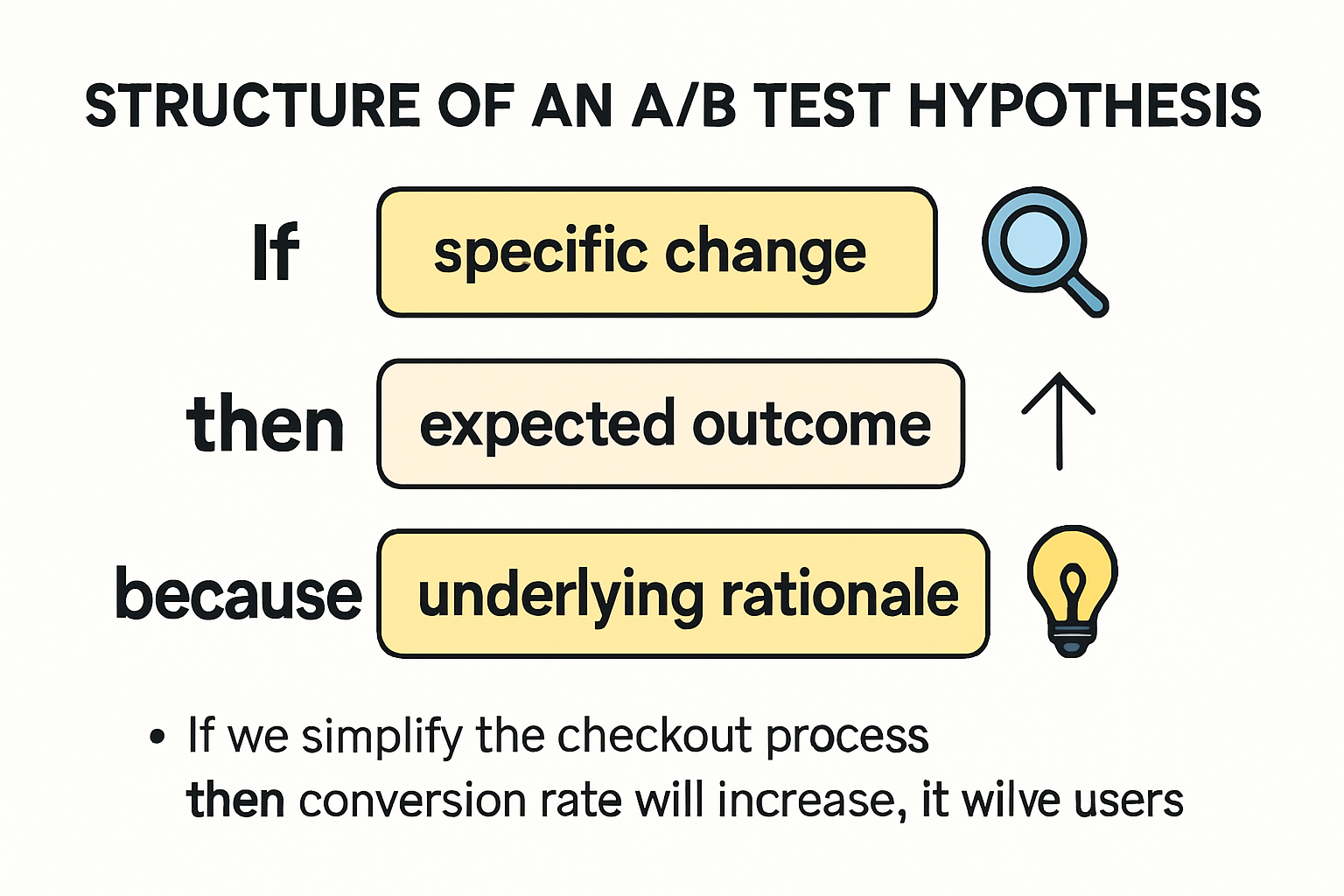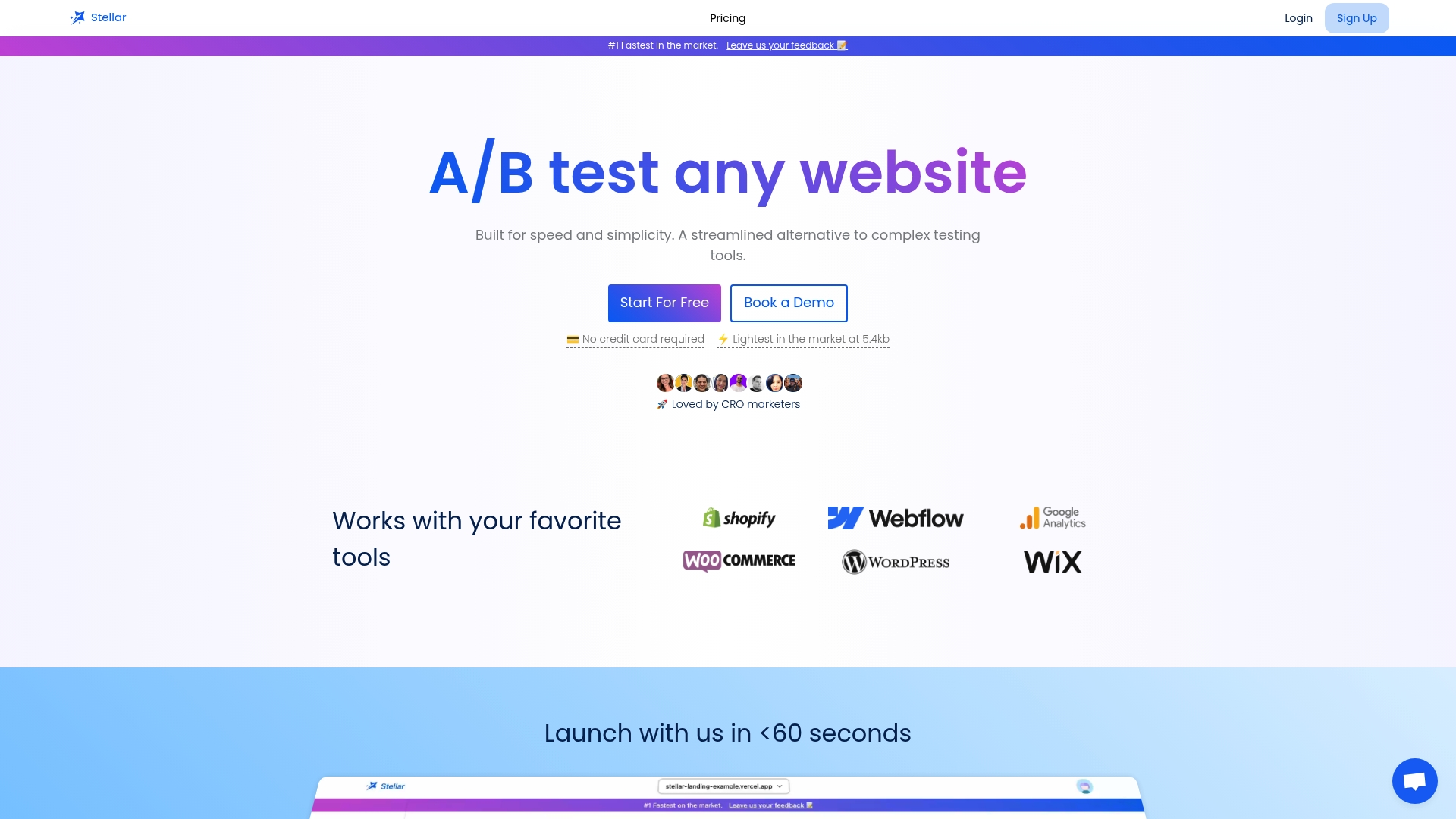
10 AB Test Hypothesis Examples for CRO in 2025

Everyone talks about A/B testing for websites, but making those experiments work is a real puzzle. Here’s something that might surprise you. A well-written hypothesis can increase your test reliability and accuracy by more than 40 percent compared to random guessing. Most people skip this step and wonder why their results never hold up. The truth is, it’s the quality of your hypothesis— not just the changes you make— that drives real conversion growth.
Table of Contents
- What Makes A Strong AB Test Hypothesis
- Real AB Test Hypothesis Examples For CRO
- How To Write And Validate Your Own Hypotheses
- Tips For Analyzing AB Test Results Effectively
Quick Summary
| Takeaway | Explanation |
|---|---|
| Strong Hypothesis Framework | A powerful AB test hypothesis should follow the format: "If [specific change], then [expected outcome], because [underlying rationale]" to ensure it is data-driven and measurable. |
| Specific and Measurable Characteristics | Effective hypotheses must be specific, measurable, testable, and grounded in user data to enhance reliability and address specific user challenges. |
| Focused Testing on User Experience | Each hypothesis should explore a particular user problem, aiming to identify solutions based on data analysis, user behavior understanding, and existing research. |
| Rigorous Analysis of Results | When analyzing test results, prioritize statistical significance, comprehensive metric evaluations beyond primary conversion rates, and consider external influences to mitigate analysis risks. |
| Iterative Learning Process | A/B testing is an ongoing process; each test provides insights that contribute to future hypothesis refinement and strategic decision-making. |
What Makes a Strong AB Test Hypothesis
Crafting a powerful AB test hypothesis is the cornerstone of effective conversion rate optimization. A robust hypothesis transforms random testing into strategic experimentation, providing clear direction and measurable outcomes for digital marketers and product teams.
The Anatomy of an Effective Hypothesis
A strong AB test hypothesis isn't just a wild guess. It's a carefully constructed statement that follows a precise framework. According to research from Compose, the most effective hypotheses follow a structured format: "If [specific change], then [expected outcome], because [underlying rationale]".
This structure ensures that your hypothesis is not just a shot in the dark, but a data-driven prediction rooted in observable user behavior and strategic insight. For instance, instead of saying "We think changing the button color might help," a stronger hypothesis would be "If we change the call-to-action button from blue to green, then conversion rates will increase by 15% because green creates a sense of urgency and aligns with psychological triggers of action."

Key Components of a Robust Hypothesis
Effective AB test hypotheses share several critical characteristics. Research from KDNuggets highlights that successful hypotheses must be:
- Specific: Clearly define the exact change you're testing
- Measurable: Include quantifiable metrics and expected outcomes
- Testable: Ensure the hypothesis can be validated through statistical analysis
- Grounded in Data: Base your hypothesis on existing user research, analytics, or behavioral insights
Consider the context of your user experience. A hypothesis isn't just about making changes but understanding the underlying user motivations. For example, if analytics show high cart abandonment rates, your hypothesis might explore how simplified checkout processes or clearer pricing information could reduce friction.
Moreover, data from ResearchGate emphasizes that hypotheses grounded in comprehensive research yield more reliable results. This means diving deep into user behavior, examining heatmaps, session recordings, and conducting user interviews to understand potential conversion barriers.
When developing your hypothesis, ask critical questions: What specific user problem are you solving? What evidence suggests this change might improve user experience? How will you measure success?
Learn more about optimizing your testing strategy, our comprehensive guide breaks down advanced techniques for creating impactful hypotheses that drive meaningful improvements in conversion rates.
Real AB Test Hypothesis Examples for CRO
Converting website visitors into customers requires strategic experimentation and precise hypothesis testing. Real world A/B test hypotheses provide actionable insights that can dramatically improve conversion rates across digital platforms.
Landing Page Conversion Hypotheses
Landing pages represent critical conversion touchpoints where even minor adjustments can yield significant results. Consider this specific hypothesis: "If we reduce the number of form fields from five to three, then our lead generation conversion rate will increase by 20% because shorter forms reduce user friction and cognitive load."
Another compelling landing page hypothesis might be: "If we add social proof elements like customer testimonials and trust badges near the call-to-action button, then sign-up rates will improve by 15% because these elements build credibility and reduce user hesitation."
Here is a table summarizing the real AB test hypothesis examples from the landing page, ecommerce, and email/CTA sections, including the change, expected impact, and rationale for each:
| Hypothesis Change | Expected Outcome | Rationale |
|---|---|---|
| Reduce form fields from five to three | Lead generation rate increases by 20% | Shorter forms reduce user friction and cognitive load |
| Add testimonials and trust badges near CTA | Sign-up rates improve by 15% | Builds credibility and reduces user hesitation |
| Implement a progress indicator in checkout | Cart abandonment decreases by 12% | Users feel informed and in control, reducing drop-off |
| Personalize email subject lines by name and segment | Open rates increase by 25% | Personalized emails feel more relevant and engaging |
| Change CTA button color from blue to green and enlarge it by 20% | CTR improves by 18% | Contrasting color and larger size attract attention and create urgency |
Ecommerce Checkout Optimization Hypotheses

Ecommerce platforms frequently leverage A/B testing to streamline purchasing processes. A nuanced hypothesis could be: "If we implement a progress indicator showing the simplified checkout steps, then cart abandonment rates will decrease by 12% because users feel more informed and in control of their purchasing journey."
Additionally, explore our comprehensive guide on conversion strategies to understand advanced testing methodologies that transform user experience.
Email and Call-to-Action Hypotheses
Email marketing presents another fertile ground for hypothesis testing. An example might be: "If we personalize email subject lines using the recipient's first name and segment-specific language, then open rates will increase by 25% because personalized communication feels more relevant and engaging."
For call-to-action optimization, consider this hypothesis: "If we change our primary CTA button color from blue to green and increase its size by 20%, then click-through rates will improve by 18% because the more prominent, contrasting color creates visual urgency and attracts user attention."
Successful A/B testing demands rigorous documentation. Each hypothesis should clearly articulate the proposed change, expected outcome, and underlying rationale. While not every test will produce dramatic results, consistent experimentation builds a robust understanding of user behavior and preferences.
Remember that effective hypotheses are not just about making random changes but about solving specific user experience challenges. By grounding your tests in data, user research, and clear strategic objectives, you transform A/B testing from a guessing game into a precise optimization tool.
How to Write and Validate Your Own Hypotheses
Developing robust A/B test hypotheses requires a strategic approach that combines analytical thinking, user insights, and methodical validation. The process of creating and testing hypotheses is not just about generating ideas but about transforming those ideas into measurable, actionable experiments.
Crafting a Systematic Hypothesis Framework
A powerful hypothesis begins with structured thinking. According to LinkedIn research, effective hypotheses follow the SMART criteria: Specific, Measurable, Actionable, Relevant, and Testable.
To construct a comprehensive hypothesis, follow this detailed template:
- Identify the Problem: What specific user experience challenge are you addressing?
- Propose the Change: What exact modification will you implement?
- Predict the Outcome: What measurable impact do you expect?
- Define the Rationale: Why do you believe this change will work?
For example: "If we simplify the registration form by removing non-essential fields, then user sign-up completion rates will increase by 22% because reduced cognitive load minimizes user friction."
To help organize the key steps for crafting your own hypothesis, here is a process table summarizing the framework provided in this section:
| Step | Description |
|---|---|
| Identify the Problem | Define the specific user experience challenge |
| Propose the Change | Specify the exact modification to implement |
| Predict the Outcome | Describe the measurable impact expected |
| Define the Rationale | Explain why the change should work based on data or insights |
Validating Hypothesis Reliability
Research from AWA Digital emphasizes the critical importance of determining appropriate sample sizes and test durations. Statistical validity requires careful planning:
- Run tests for a minimum of 1-2 weeks to account for traffic variations
- Use power calculators to estimate minimum sample sizes
- Consider baseline conversion rates and minimum detectable effects
- Factor in potential seasonal traffic fluctuations
Explore our advanced testing strategies to understand nuanced validation techniques that enhance experimental accuracy.
Statistical Validation and Error Prevention
Cutting-edge research from ArXiv highlights sophisticated methods for hypothesis validation. Empirical approaches like analyzing resampled A/A tests can help assess underlying statistical assumptions and prevent potential Type-I errors.
Key validation strategies include:
- Conducting A/A tests to establish baseline statistical noise
- Implementing robust statistical significance thresholds
- Using confidence intervals to understand result reliability
- Accounting for potential confounding variables
Successful hypothesis creation is an iterative process. Each test provides insights that refine future experimentation. By maintaining a disciplined approach to hypothesis development and validation, marketers can transform intuitive guesses into data-driven optimization strategies.
Remember that not every hypothesis will yield dramatic results. The true value lies in consistent experimentation, meticulous documentation, and a willingness to learn from both successful and unsuccessful tests. Your hypotheses are living documents that evolve with each iteration of testing and analysis.
Tips for Analyzing AB Test Results Effectively
Analyzing A/B test results is a nuanced process that requires more than simply comparing two sets of numbers. Effective result interpretation demands a strategic approach that goes beyond surface-level metrics and uncovers deeper user insights.
Understanding Statistical Significance
Research from Invesp emphasizes the critical importance of establishing robust statistical parameters before drawing conclusions. Statistical significance isn't just about finding a winner, but understanding the reliability of your results.
Key considerations for meaningful analysis include:
- Determining appropriate confidence levels (typically 95% or 99%)
- Calculating statistical power
- Identifying the minimum detectable effect size
- Avoiding premature conclusions based on limited data
A common mistake is stopping a test too early or interpreting results without understanding the underlying statistical principles. Professional analysts recommend running tests long enough to collect substantial data and ensure the observed differences aren't merely random fluctuations.
Comprehensive Metric Evaluation
According to OptimOnk, effective result analysis extends far beyond primary conversion rates. Successful marketers dive deep into secondary metrics and segment-specific insights.
Consider evaluating:
- User Engagement Metrics: Time on page, scroll depth, interaction rates
- Segmentation Analysis: Performance across different user demographics
- Device-specific Performance: Variations in results across mobile, tablet, desktop
- Behavioral Patterns: How different user groups respond to variations
Discover advanced analytics techniques to unlock deeper understanding of your experimental results.
Mitigating Analysis Risks
Insights from advanced testing methodologies highlight the importance of comprehensive sanity checks and external factor considerations.
Risk mitigation strategies include:
- Conducting pre-test balance checks between control and variant groups
- Monitoring potential external influences like seasonal trends
- Accounting for concurrent marketing activities
- Verifying tracking and implementation accuracy
- Documenting potential confounding variables
Remember that A/B testing is an iterative process. A single test result isn't a definitive endpoint but a stepping stone toward continuous optimization. Approach each analysis with curiosity, rigor, and a commitment to understanding the nuanced story behind the numbers.
Effective result analysis transforms raw data into actionable insights. By maintaining a disciplined, multi-dimensional approach to interpretation, marketers can uncover meaningful patterns that drive strategic decision-making and sustainable conversion improvements.
Frequently Asked Questions
What makes a strong A/B test hypothesis?
A strong A/B test hypothesis is specific, measurable, testable, and grounded in data. It typically follows the format: "If [specific change], then [expected outcome], because [underlying rationale]" to ensure it drives effective experimentation.
How can I write my own A/B test hypotheses?
To write your own hypotheses, identify the user problem you aim to address, propose a specific change, predict the expected outcome, and define the rationale behind your prediction based on user data and insights.
What are some examples of A/B test hypotheses for e-commerce?
Examples include: "If we implement a progress indicator in the checkout process, then cart abandonment will decrease by 12% because users feel more informed" and "If we offer personalized product recommendations, then average order value will increase by 15% because users are presented with options tailored to their interests."
How do I analyze the results of my A/B tests effectively?
To analyze A/B test results effectively, establish statistical significance, evaluate comprehensive metrics beyond conversion rates, segment data for more insights, and consider any external factors that may influence results.
Ready to Turn Your Hypotheses Into Real Conversion Wins?
It is not easy to take well-crafted A/B test hypotheses and translate them into actual business growth. Maybe you recognize those pain points from the article: tossing hours into set-up, worrying whether your data is trustworthy, or struggling to quickly see if your hypothesis pays off. You want the confidence that your testing process is both fast and accurate, but technical hassles or slow reporting keep getting in the way. If you are aiming for data-driven results on a budget and with no coding, you should not settle for less.

Now you can take the guesswork out of your conversion rate optimization. With Stellar's no-code A/B testing platform, you get everything you need to validate your top hypotheses with ease. Enjoy one of the market’s fastest tools with a lightweight 5.4KB script so your site performance stays untouched. Make changes visually, see instant impact with real-time analytics, and track every goal without complex set-up. Thousands of marketers already trust Stellar to move from theory to results.
Take your next step and start optimizing your landing pages faster. Sign up today at Stellar to see how easy it is to run smarter experiments and grow your conversions—before your competitors do.
Recommended
- Conversion Rate Optimization Strategies for Marketers in 2025
- Testing to Optimize Conversions: CRO Strategies for 2025
- SEO AB Test Strategies for CRO Marketers in 2025
- Conversion-Optimierung 2025: Die besten Strategien für Marketer
- SEO Meets CRO: Testing Solutions That Boost Rankings
- 10 Inspirerende AB-test Voorbeelden voor CRO-marketeers in 2025
Published: 7/14/2025
